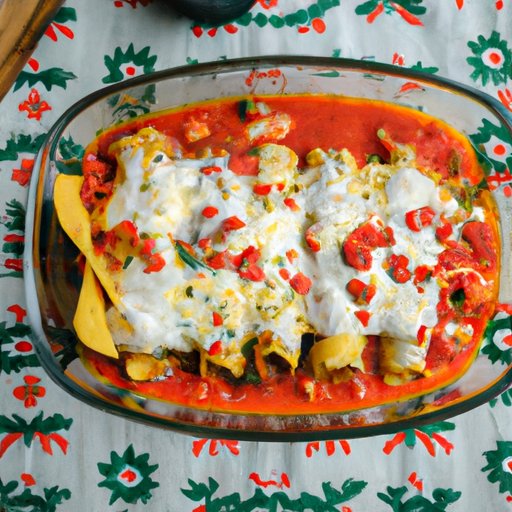Introduction
Enchiladas are a classic Mexican dish that has gained immense popularity all over the world. This baked dish comprises of tortillas rolled around various fillings and topped with a delicious sauce. With many variations of the recipe and countless ingredient options, enchiladas are a versatile dish that caters to all dietary needs and personal preferences.
In this article, we will provide you with a step-by-step guide to making authentic enchiladas with a tasty sauce and fillings. We will also explore the history and cultural significance of this dish, alternative ingredients, regional variations, and prep instructions. By the end of this article, you will be well-equipped to make delicious enchiladas in the comfort of your own home.
Step-by-Step Guide to Making Traditional Enchiladas
Here is a step-by-step guide to making enchiladas at home:
Gather all necessary ingredients and tools
Before you begin, make sure you have all the ingredients and tools required to execute the recipe with ease. This includes tortillas, filling ingredients, enchilada sauce, cheese, and any toppings you wish to add. You will also need a baking dish and cooking utensils such as a pot and spatula.
Prep the sauce and fillings
To make enchilada sauce:
- Heat a tablespoon of oil in a pan and add chopped onions and garlic. Sauté until translucent.
- Add tomatoes, tomato paste, and all of the spice powders such as chili powder, cumin, and smoked paprika. Cook for another 5-7 minutes till fragrant and thickened.
- Blend the mixture until smooth.
For the filling:
- Start by cooking the protein of your choice with a variety of vegetables, beans or legumes, and spices as required.
- Shred cooked chicken or beef, or roast cauliflower to make a vegetarian option. Add cheese, black beans, corn, or any other additional ingredients of preference.
Assemble the enchiladas
- Preheat the oven to 350ºF. Take a baking dish and spread a little enchilada sauce on it.
- Dip each tortilla in the sauce, fill with the filling in the center, and roll up tightly. Place seam side down in the baking dish. Repeat with remaining tortillas and filling until your baking dish is filled.
Bake the enchiladas
- Pour any remaining enchilada sauce over the tortillas and sprinkle with grated cheese.
- Bake uncovered for 20-25 minutes in the oven until the cheese is melted and bubbly.
Optional: Serve with toppings
- Top your enchiladas with any desired toppings, such as avocado, sour cream, jalapeños, or cilantro.
- Serve hot and enjoy!
The History and Origins of Enchiladas
Enchiladas stem from ancient Mesoamerican cuisine and date back as early as Mayan culture. The dish includes a combination of indigenous and Spanish influences, such as tortillas and tomato-based sauces.
Today, enchiladas are a beloved dish in many countries, and variations of the recipe have developed, blending local ingredients and cultural influences to create a rich, flavorful dish.
Here are a few classic variations of the recipe and the cultural significance of each:
- Enchiladas verdes: Made with green chili sauce and chicken, garnished with cheese and sour cream.
- Enchiladas suizas: Named for “Swiss” or French influence, these enchiladas are smothered in a creamy white sauce and typically include chicken or pork filling.
- Enchiladas molé: This variation combines ingredients such as chocolate and spices to create a rich, complex sauce. Fillings may include beef, chicken, or cheese.
Here are a few variations for you to try:
- Spinach and Cheese Enchiladas: a delicious vegetarian option
- Seafood Enchiladas: made with shrimp or crabmeat, a light and fresh variation
- Black Bean and Corn Enchiladas: a simple and healthy option for those on a plant-based diet
Alternative Ingredients for Enchiladas
Enchiladas offer a wide range of ingredient options, making it an ideal dish for vegetarians, vegans, and health enthusiasts. Here are some vegetarian protein options to consider:
- Black beans
- Chopped tofu
- Roasted sweet potato
- Quinoa and black-eyed peas
- Sautéed mushrooms
By swapping out traditional meat fillings and incorporating plant-based options into the recipe, you can make enchiladas that are just as delicious and protein-packed.
Regional Enchilada Recipes
As previously mentioned, enchiladas have various geographically influenced variations that make for a unique gastronomic experience. Here are some regional enchilada recipes to try:
Tex-Mex Style Enchiladas
This variation features rolled tortillas filled with chili powder-spiced ground beef, slow-cooked in a mild chili gravy sauce, and smothered in cheese.
Enchiladas Sonorenses
This variation hails from Sonora, a state in northwestern Mexico. It is characterized by roasted beef and green chili sauce, garnished with cheese, onion, and ground chili peppers.
Enchiladas Tapatías
Originating from the city of Guadalajara in Jalisco state, these enchiladas are known for their spiciness. They are often filled with spiced pork and breakfast potatoes and served with jalapeños and onions.
Experimenting with these regional variations can open up a whole world of new flavors and take your enchilada making skills to the next level!
Efficient Prepping Process
Prepping ingredients before beginning the cooking process is crucial. Here are some tips to prep more efficiently and precisely:
- Chop all veggies and ingredients before cooking anything.
- Organize ingredients within reach and arrange them for easy grabbing.
- Use a food processor or blender to blend sauce ingredients.
- Measure all ingredients before cooking to save time and ensure accuracy.
Common Mistakes and Prevention Techniques
Here are some common mistakes to avoid:
- Not dipping the tortillas in the sauce: dipping ensures they are soft and won’t crack when rolled.
- Overfilling the tortillas: too much filling will cause them to burst or fall apart.
- Forgetting to preheat the oven: preheat before beginning cooking to save time and ensure even baking.
- Making insufficient enchilada sauce: make enough sauce to cover all tortillas evenly.
Conclusion
Enchiladas are an incredibly diverse, flavorful, and customizable dish that appeals to a wide range of tastes and dietary preferences.
